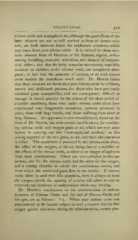Page 481 - My FlipBook
P. 481
NITROUS OXIDE.
479
nitrous oxide and atmospheric air, although the good effects of the
latter mixture are not so well marked as "those of former mix-
ture, yet both mixtures lessen the unpleasant symptoms which
may ensue from pure nitrous oxide. It is claimed for these mix-
tures absence from all blueness of the features, regular, softly-
snoring breathing, muscular relaxation, and absence of conjunc-
tival reflex ; also that the jerky muscular movements, especially
common to children under nitrous oxide, are completely abro-
gated ; in fact that the presence of oxygen, or air with nitrous
oxide renders the anaesthesia much safer. Dr. Hewitt claims
that these mixtures are better than pure nitrous oxide for children,
anemic and debilitated patients, for those who have previously
exhibited great susceptibility, and are consequently difficult to
manage in dental practice for the reason of the short period of
available anesthesia, those who under nitrous oxide alone have
experienced very disagreeable sensations, patients advanced in
years, those with large tonsils, and those suffering from heart or
lung diseases. An apparatus is now manufactured, based on the
ideas of Dr. Hewitt, but with certain modifications, for combin-
ing nitrous oxide and oxygen gases or air, which are very satis-
factory in carrying out this " non-asphyxial method," as this
mixing together of the two gases, or air, and their administration
is called. The anaesthesia is produced by the nitrous oxide alone,
the office of the oxygen, or the air, being that of a modifier of
the effects of the nitrous oxide, as there is no danger of asphyxia
from such combinations. There are two cylinders in this ap-
paratus, one for the nitrous oxide and the other for the oxygen,
and a mixing chamber in which the combination occurs, and
from which the combined gases flow to the inhaler. If nitrous
oxide alone is used with this apparatus, there is always on hand
the oxygen, which the opening of a valve will admit at once to
overcome any tendency to asphyxiation which may develop.
Dr. Hewitt's conclusions on the administration of definite
mixtures of Nitrous Oxide and Air and of Nitrous Oxide and
Oxygen, are as follows: "i. When pure nitrous oxide was
administered to the human subject in such a manner that no free
oxygen gained admission during the administration, certain phe-


